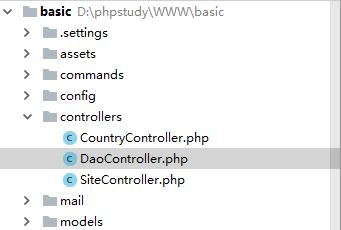Yii2访问自定义模块下的controller
Posted 桔子桑
tags:
篇首语:本文由小常识网(cha138.com)小编为大家整理,主要介绍了Yii2访问自定义模块下的controller相关的知识,希望对你有一定的参考价值。
之前,由于所要访问的controller都是位于根目录下的controllers目录下,就像下面这样:

此时,我们可以直接通过 localhost/basic/web/index.php?r=dao/index 来访问图中DaoController.php里的actionIndex。
但是如果,我们将controller、view等有关联的独立出来作为一个模块Modules,那么又将怎样去处理呢。

就像上面这样,这个Site控制器里面的action又将如何访问呢。
1.建立目录
首先建立如上的目录结构,在api下的以及目录有三个文件夹和一个文件Module.php,这个php文件内容如下:
<?php namespace app\\modules\\api; /** * api module definition class */ class Module extends \\yii\\base\\Module { /** * @inheritdoc */ public $controllerNamespace = \'app\\modules\\api\\controllers\'; /** * @inheritdoc */ public function init() { parent::init(); // custom initialization code goes here } }
这个文件可以直接复制,无需作任何修改,只是注意红字部分的命名空间,不要写错了!
2.web.php
还记得项目根目录下的config文件夹下有个web.php文件么,添加如下字段:
<?php $params = require __DIR__ . \'/params.php\'; $db = require __DIR__ . \'/db.php\'; $config = [ \'id\' => \'basic\', \'basePath\' => dirname(__DIR__), \'bootstrap\' => [\'log\'], \'aliases\' => [ \'@bower\' => \'@vendor/bower-asset\', \'@npm\' => \'@vendor/npm-asset\', ], \'components\' => [ \'request\' => [ // !!! insert a secret key in the following (if it is empty) - this is required by cookie validation \'cookieValidationKey\' => \'jjsYJ_ju0W8ifOv5mY3JBMI6DOppFlo6\', ], \'cache\' => [ \'class\' => \'yii\\caching\\FileCache\', ], \'user\' => [ \'identityClass\' => \'app\\models\\User\', \'enableAutoLogin\' => true, ], \'errorHandler\' => [ \'errorAction\' => \'site/error\', ], \'mailer\' => [ \'class\' => \'yii\\swiftmailer\\Mailer\', // send all mails to a file by default. You have to set // \'useFileTransport\' to false and configure a transport // for the mailer to send real emails. \'useFileTransport\' => true, ], \'log\' => [ \'traceLevel\' => YII_DEBUG ? 3 : 0, \'targets\' => [ [ \'class\' => \'yii\\log\\FileTarget\', \'levels\' => [\'error\', \'warning\'], ], ], ], \'db\' => $db, /* \'urlManager\' => [ \'enablePrettyUrl\' => true, \'showScriptName\' => false, \'rules\' => [ ], ], */ ], \'modules\' => [ \'api\' => [ \'class\' => \'app\\modules\\api\\Module\', ], ], \'params\' => $params, ]; if (YII_ENV_DEV) { // configuration adjustments for \'dev\' environment $config[\'bootstrap\'][] = \'debug\'; $config[\'modules\'][\'debug\'] = [ \'class\' => \'yii\\debug\\Module\', // uncomment the following to add your IP if you are not connecting from localhost. //\'allowedIPs\' => [\'127.0.0.1\', \'::1\'], ]; $config[\'bootstrap\'][] = \'gii\'; $config[\'modules\'][\'gii\'] = [ \'class\' => \'yii\\gii\\Module\', // uncomment the following to add your IP if you are not connecting from localhost. //\'allowedIPs\' => [\'127.0.0.1\', \'::1\'], ]; } return $config;
为了避免看的时候出错,上面红字的“键”是出于同一级的,红字加粗的是我们为modules添加的相关配置信息,相当于在应用中注册了刚才定义的组件(api)。
3.api组件下的controllers
现在我们在Modules/api/controllers下新建一个SiteControllers.php,内容如下:
<?php namespace app\\modules\\api\\controllers; use yii\\web\\Controller; class SiteController extends Controller { public function actionIndex() { echo "hello world"; } }
注意命名空间就好~~~
4.浏览器访问
最后就是浏览器访问这个actionIndex了,浏览器输入: http://localhost/basic/web/index.php?r=api/site/index

至此,结束~~~
以上是关于Yii2访问自定义模块下的controller的主要内容,如果未能解决你的问题,请参考以下文章